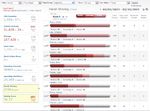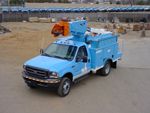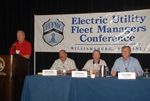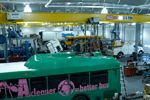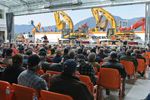Modernizing Your Shop: Solution Implementation
In the last issue of Utility Fleet Professional, we looked at what factors affect productivity in your current shop, how to calculate space and technician needs, and the options available to you once you determine you want to upgrade your existing shop or build a new facility. Now it’s time to explore the design and implementation process. This article will cover everything you need to know, from the different project phases to site selection considerations to the solicitation of bids and beyond.
Project Inception
Considerations at the inception of the project for either an expansion or build alternative should encompass the following:
• The goal is to reduce costs, increase safety and improve productivity.
• The cost to rehabilitate the present facility is only $125 per square foot.
• The equipment cost is 30-35 percent of the facility cost.
• The ratio of vehicles per square foot of facility.
• Circulation with inside versus outside storage.
• A new facility costs roughly $200 per square foot, plus an equipment cost at 33 percent of the square footage estimate, which is approximately $65 per square foot or an estimated $265 per square foot total.
• Twelve feet of mortar equals 18 feet of steel equals 30 feet of outside height or 26-28 feet of inside height.
• Allow for electrical, water, steel, mortar and a 10-foot concrete apron around the facility.
• Follow Wicks Law regarding the on-site supervision of the general contractor. Wicks Law states that federal funding for local projects requires a general contractor to oversee all costs as the project progresses to prohibit unnecessary change orders that needlessly increase costs.
Project Sequence
Most renovation projects typically follow this type of sequence:
• Pre-design, which includes gathering input from the fleet manager, architect and designer.
• Schematic design (six months).
• Design development (12 months).
• Contract documents development (six months).
• Request for bids, receipt of quotes and award of contract (six months).
• Design build, which takes approximately 24 months and is a combination of the preceding three line items.
• Wicks Law for construction management of federally funded projects requires an extra level of project management to supervise the general contractor. This is done to ensure that government policies and procedures are followed.
• Site progress, which includes developing a schedule and retainage.
• Involve prime contractors and subcontractors, and hold coordination meetings.
• Wrap-up, warranty, facility use program and move-in.
• Testing followed by final payment.
• On-site, turnkey and warranty management.
• Liquidated damages for latent defects.
Shop Design Sequence
The pre-design stage is a line sketch of the desired layout including items such as general sizing, stockroom, shop administration offices, lighting, plumbing, electrical, water, air, supplies, work areas, lockers, support areas, washrooms, and welding and cleaning areas. The occupant and construction management firm architect will rough out footprint processes, topography and compatibilities. This process can take up to six months with timing, what-ifs, changes, and the learning curve of the customer and architect. The most knowledgeable party is the customer who fits into the facility; the architect suggests, but the customer is both accountable and responsible.
The following must be considered in the pre-design stage:
• Pre-design of the site including site selection, site short list and cost considerations.
• Input from fleet managers, administrative personnel, shop personnel and drivers.
• Clerical needs including equipment and work flow.
• Work methods and changes.
• Design layout: architect versus client versus consultant.
• Drawing drafts of the present building that include scale, access and inside versus outside.
• Revisions to the present building including limits, codes to follow, and required permits and fees.
• Meetings:
o Bid preparation, solicitation of bids, and evaluation of bids and bidders.
o Awards: schedule start and track progress.
• Construction site progress:
o Penalties for on-site progress.
o Coordination meetings.
o Changes.
• Completion, warranty, retainage and date of return for evaluation.
Site Selection
Site selection involves consideration of the following:
• Cost to prepare the site.
• Demolition of the site; full and/or partial liability for contaminated sites.
• Site inspection; estimated renovation or rehabilitation required.
• Environmental issues, drainage considerations and wildlife protection.
• Mileage variations to the new facility and cost adjustment.
• Facility growth for five years, 10 years and beyond.
• Alternative fuel use to offset capital outlay.
• Utility access for water, electric and gas.
• Traffic flow.
Layout Alternatives
The following are layout alternatives:
• Stock room access.
• Floor drains: slope.
• Lights: natural and artificial.
• 110-, 220- and 440-volt outlets.
• Ventilation and skylights.
• Concrete finish.
• Water and air lines: freezing.
• Epoxy: hardening.
• Storage: light and heavy.
• Seal and color of concrete.
• Fans for heat and ventilation.
• Compressed air.
• Heavy-duty: workbench, light and air.
• Roof-mounted equipment.
• Drawers: rollout and slide-out.
• Roof integrity: ladders.
• Floor access versus overhead access.
• Floor bolting and painting.
• Oil, air, water and electrical disposal.
• Welding, gas and electric.
• Three-quarter- to half-inch: psi range.
• Posts and doors.
• Antifreeze: new and recycled.
• Brakes and drums.
• Silicon: permanent extended life.
• Cranes: overhead versus jib.
• Recovered oil: antifreeze.
• Waste storage.
• Hazardous versus residual versus commercial wastes.
• Primary, secondary and tertiary storage of hazardous material wastes.
• Line painting: safety.
• Vehicle exhaust system.
• Corner guards.
• Exhaust temperature.
• Convex mirrors.
• Electric fuse box index.
• Mark piping: color code fluid lines.
• Downspout: cast versus aluminum.
• Fifty candlepower at floor level.
• Continuous floor drain: inside diameter.
• Concrete aprons.
• Shop drains: oil water separator.
• Battery room.
Schematic Design
The next step is a schematic design phase during which a layout is drawn to scale, incorporating the customer’s wants and needs and fitting in equipment, HVAC, electrical and plumbing, plus general construction specifications and upgrade of pre-design ideas into acceptable reality. The architect brings experience to the following areas:
• Considerations of present work flow space.
• Whether to leave or transfer present equipment.
• Drafting a new, site-specific layout and defining dimensions.
• Identifying equipment.
• Stating the location of equipment.
• Proposing the fit of equipment in the location.
• Drafting dimensions for electric and fluid needs.
• Brainstorming meetings.
Schematic design issues include the following:
• The new facility is site specific.
• This will alter the present footprint and practices.
• Receptiveness of the occupant to the new layout.
• The cost of change from present practices to new practices.
• The cost per square foot of the new facility for budget purposes.
• Project start date.
• Present date.
• Budget changes.
• Build date.
Design Development
The next stage is design development, which is a solicitations document phase. The architectural drawings are priced from the schematic design phase, and the funding needed is dedicated to this project. If the funding is inadequate, the schematic design phase must be altered to fit the funding, which must include inflation because it will take two to four years to solicit, award, and initiate the project and accommodate the changes.
Retainage – when the general contractor, prime subcontractors and subcontractors are paid, minus a percentage that will be held for warranty resolution – must be defined at this point. What are the amounts, terms and conditions? Target retainage is 15 percent, negotiable to 5 percent. Payment times are six months from the date of occupancy, and any changes have a six-month warranty extension tied to the finish date of that change.
The following elements are included in the design development:
• Drawing submissions and review; traffic and work flow; as-built and final drawings.
• Unique issues:
o Work methods.
o Utilities.
o Communication and time clocks.
o Data processing.
o Security.
• Administration, shop, offices and parking:
o Access for pedestrians and vehicle flow.
o Numbering, odd and even parking spaces.
• Tools and equipment, electric, water and effluent.
• Shop needs:
o Rebuild, repair or preventive maintenance.
o Painting.
o Bodywork.
o Washing.
o Cleaning.
Strategies and Expectations
Strategies
• Follow Wicks Law with a construction management plan.
• Provide construction management of the general contractor, prime contractors and subcontractors.
• Consider design build versus design and build by one or many architects and engineering firms.
• Company management of the architect and builder.
• Bid preparation, solicitation, evaluation and award.
• Start date, work schedule and coordination meetings.
• Meetings for site selection, design, schedule and site remediation as to its footprint.
• Payment and change orders, threshold limits and penalties.
• Warranty and retainage, training and manuals.
Management Expectations
• Construction progress updates, pictures and videos.
• Script: outline, lesson plan and library of videos.
• Facility maintenance schedule and tasks.
• Application-specific manuals for parts and service.
• Warranty and latent defects and liquidated damages.
• Extended warranty, replacement warranties and double extensions.
Equipment Program
A good equipment program involves consideration of the following:
• Specifications and cut sheet.
• Power: location and work flow.
• Delivery, setup and training.
• Acceptance and payment.
• Warranty and 5 percent estimated retainage.
• Liquidated damages for latent defects.
• Videos:
o One thousand dollars per minute, finished product and multiple choices.
o Tripod, script, outline and lesson plan.
o Equipment vendor instructor.
• Move-in:
o Parts, supplies and materials first (weekend one).
o Skeleton staff (weekday).
o Maintenance and repair staff and their tools (weekend two).
o Transition from one weekend to another weekend.
• A person on-site to manage the warranty-poor materials, poor workmanship and design defects.
A critical issue is that the customer who occupies the finished facility expects a turnkey environment. An experienced architectural and engineering firm will provide a professionally qualified employee to be on-site to manage the 5 percent retainage. This person will sit with the customer, teach him or her how the facility is designed to work, and walk him or her through that process. This costs one person’s salary for six to 18 months depending on the complexity and sophistication of the facility and the equipment installed.
Design development is the time during which specifications are developed for the facility and its equipment for solicitation. These specifications must be a combination of functional and technical details and should include training needs, service, parts and supply books, CDs organized in a standard format with a defined warranty for latent defects (i.e., design defects not readily recognizable), and installation expectations with liquidated damage (late installs) documentation for penalties.
Solicitation of Bids and Award
The solicitation phase details all phases so that subcontractors, prime contractors, general contractors and construction management firms can delineate their costs while being aware of specific time and quality issues.
The design documents convey expectations in every detail so that bid prices can be compared, with the best bid being the lowest bid that addresses all issues. Should the award be split, portions can be divided accurately and a valid comparative analysis can be made.
The next phase is to solicit the contract documents for a request for proposal, where the terms and conditions are reviewed with bidders and suggestions are taken and evaluated to make the documents more accessible to more bidders. This increases competition, which leads to more competitive pricing and better responses. With the bid proposal reviewed and updated as deemed appropriate, now a request for quote can be issued. It is important to solicit as many local job site firms as possible, noting start dates of each phase and technological assignments so that one phase is completed and another can begin. Should a phase be extended unnecessarily, it will force other start times to change. In turn, this will cause schedule delays, delay the project completion date and result in a delay for the new occupant to move into the new facility.
Once the bids are received, compared, analyzed and awarded, bonds are posted along with an agreed-upon completion date.
The principals of the project are named, and the construction site is set up with temporary quarters, phones, faxes, telecommunications, personal computers, networks, offices, files, security and information published to enable all principals to communicate.
Construction Begins
Weekly meetings on the job site are scheduled; the meeting format is agreed upon; a numbered day ledger is opened; daily notes are entered; the schedule is posted; meetings are taped and noted; and the meeting minutes are circulated with timetables established, variances noted, and windows targeted and measured.
On-site progress is monitored by weekly photos from four standard locations. Videotapes are made weekly and dated for historical reference. If it is a public project, appropriate notifications are provided to funding agencies of regular meeting schedules with progress reports and change orders. Contractor changes due to nonperformance are discussed, adjusted, and resolved to keep the project on schedule and to hold costs to estimates.
Most governmental projects have regulatory requirements to communicate project progress to the different agencies that fund prorated projects (e.g., 75 percent federal, 10 percent state and 15 percent city). Each entity would contribute, at predetermined times, percentages of the total funding of the monies to pay the contracted firms. A time and completion plan is defined to direct this process.
For example, Wicks Law states that a construction management firm must monitor the progress of the general contractor, prime contractors and subcontractors; facilitate changes to keep the integrity of the program on time and uphold the quality of work; and be responsible to the funding agencies to inform them of progress and corrective actions taken to keep the project on time and at the estimated cost. This must be done on a regular basis at a minimum of monthly or targeted quarterly intervals so that payments are received on expected due dates.
During the on-site construction phase, inspectors monitor the progress in the on-site job ledger and discuss issues weekly with the prime contractors and subcontractors.
When the project is completed, a walk-through is scheduled with the general contractor, prime contractors and subcontractors. The walk-through is videotaped and a punch list is developed. Also, a written summary is drafted for tracking fixes with reference to compliance for penalty and payment validation.
Move-In Program
Around the time when closure is evident from the punch list, a move-in program is started with the client. The move-in process is defined, sequenced and prioritized, with shelving, furniture, phones, and equipment in place and tested. A temporary certificate of occupancy is obtained. A person from the construction management firm is assigned to coordinate the move, supervise the start-up, and work out the glitches and bugs with the management of the retainage so that the transition is smooth and a comfort level is established and maintained.
The occupant needs support in the day-to-day operations of the facility, in familiarity with the as-built drawings, and in problem-solving or troubleshooting of equipment problems. The on-site representative of the construction management firm is familiar with the general contractor, prime contractors and subcontractors. He or she can facilitate any problem-solving and troubleshooting with the principals, or the retainage can be used to hire other firms to correct the problems.
The on-site person’s salary and expenses could be funded from retainage. When funding runs out in 18 months, that person would leave because the momentum of the new facility would be up to speed and would meet the design and functional expectations.
Each piece of equipment should have a manual that is standardized in a common format that complements a video of the equipment operations and training, with three sets of each. One set should be kept on-site for day-to-day use, one set should be maintained in the corporate library to copy in case the on-site copy is in use or missing, and one set should be stored off-site for reference and as a copy resource.
Client Involvement
In order for the project to be successful, close interaction is required by the design team from the construction management firm, the design firm and the occupants of the new facility.
The new facility, aside from site specifics and the design complement of topography footprint, should be built around the client-occupant if the client will manage his facility for five to 10 years upon its completion. Designs and work flows are flexible and should fit the client’s needs or perceived needs.
Depending on his or her experience, the architect has a perspective that is limited because he or she does not have experience working in this or any other similar facility. Given a set of circumstances and limitations, the architect can provide alternatives based on his or her experience.
The client will use the facility day after day, so he or she will need to move seamlessly into the new facility and show increased productivity because of the features and benefits the new facility will offer.
Conclusions
Day to day there are three perspectives we need to acknowledge:
• The way one person sees it (the architect/engineer).
• The way another sees it (the occupant).
• The way it really is (general contractor and/or construction management firm).
It is the general contractor and construction management firm’s responsibility to see that the architect, engineer and occupant see what it is in the same way.
This is a once-in-a-lifetime event. You need experience and savvy to do it. If you’ve never done this before, the architect and engineer bring experience and savvy for your consideration. They understand and are attuned to help you get the facility you need to increase productivity and improve your safety experience.
About the Author: John Dolce is a fleet facility and maintenance specialist employed by Wendel Companies, an architectural and engineering firm. He is an active consultant, instructor and fleet manager with more than 40 years of experience in the public and private sector. Dolce has written three fleet-related textbooks and teaches fleet management courses at the University of Wisconsin’s Milwaukee and Madison campuses.


